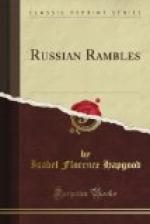“We are not pravoslavny” (Orthodox Christians), I said. But, instead of being depressed by this tacit refusal, he brightened up and plied us with a series of questions, until he really seemed to take a temporary interest in life, in place of his permanent official interest in death alone, or chiefly.
Service was in progress, in accordance with the canons of the Studieff monastery, adopted by St. Fedosy in the eleventh century. The singers, placed in an unusual position, in the centre of the church, were as remarkable for their hair as for their voices and execution. The russet-brown and golden locks of some of them fell in heavy waves to their waists. In fact, long, waving hair seemed to be a specialty with the monks of this monastery, and they wore it in braids when off duty. I had seen priests in St. Petersburg who so utterly beyond a doubt frizzed their scanty hair on days of grand festivals, that the three tufts pertaining to the three too slender hair pins on which they had been done up stood out in painfully isolated disagreement. What would they not have given for such splendid manes as these Kieff singers possessed!
We ascended to the gallery, to obtain a better view of the scene. Peasant men in sheepskins (tulupi),—the temperature verged on 100 degrees Fahrenheit,—in coats of dark brown homespun wool girt with sashes which had once been bright; female pilgrims in wadded coats girt into shapelessness over cotton gowns of brilliant hues, knelt in prayer all about the not very spacious floor. Their traveling-sacks on their backs, the tin tea-kettles and cooking paraphernalia at their belts, swayed into perilous positions as they rocked back and forth, striking the floor devoutly with their brows, rising only to throw back their long hair, cross themselves rapidly, and resume the “ground salutations,” until we were fairly dizzy at the sight. Some of them placed red, yellow, or green tapers—the first instance of such a taste in colors which we had observed—on the sharp points of the silver candelabra standing before the holy pictures in the ikonostas, already overcrowded. A monk was incessantly engaged in removing the tapers when only half consumed, to make way for the ever-swelling flood of fresh tapers. Another monk was as incessantly engaged in receiving the prosfori. A prosfora is leavened bread in the shape of a tiny double loaf, which is sold at the doors of churches, and bears on its upper surface certain symbolic signs, as a rule. The Communion is prepared from similar loaves by the priest, who removes certain portions with a spear-shaped knife, and places them in the wine of the chalice. The wine and bread are administered with a spoon to communicants. From the loaves bought at the door pieces are cut in memory of dead friends, whose souls are to be prayed for, or of living friends, whose health is prayed for by the priest at a certain point of the service, in




